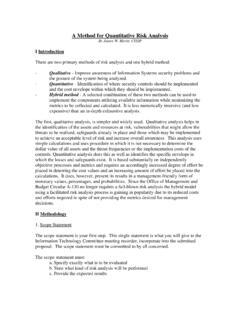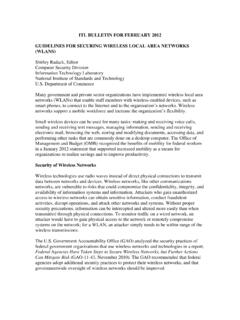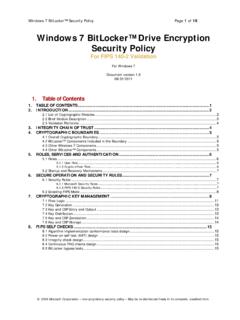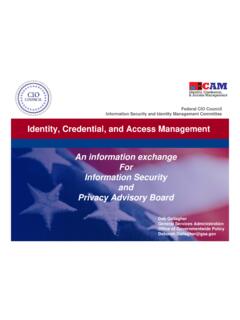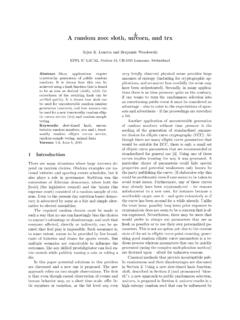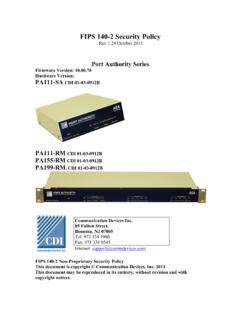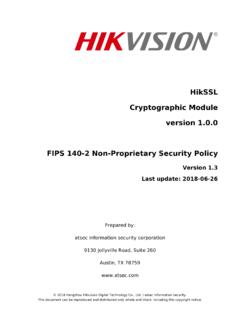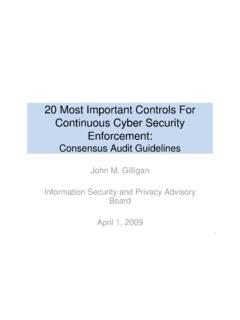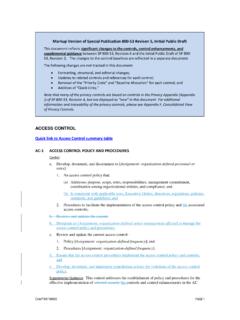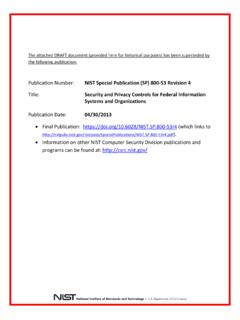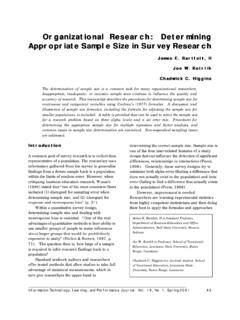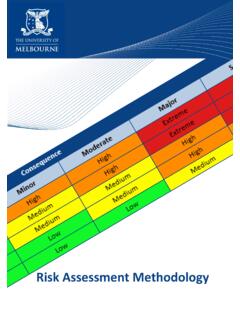Transcription of NIST RMF Quick Start Guide
1 1 2021-3-11 NIST RMF Quick Start Guide AUTHORIZE STEP Frequently Asked Questions (FAQs) MANAGEMENT FRAMEWORKNISTNIST Risk Management Framework (RMF) Authorize Step he Authorize step provides organizational accountability by requiring a senior management official to determine if the security, privacy, and supply chain risk to organizational operations, assets, individuals, other organizations, or the Nation is acceptable based on the operation of a system or the use of common controls. The senior agency official for privacy is required to review authorization materials for systems that process personally identifiable information. Before a system is put into operation (or continues to operate), a valid authorization to operate is required. Contents General Authorize Step FAQs .. 2 1. What has been modified from NIST SP 800-37, Rev. 1, to NIST SP 800-37, Rev. 2, for the Authorize step? .. 2 2. What is the purpose of the Authorize step?
2 3 3. What happens during the risk analysis and determination task? .. 3 4. What artifacts are in the authorization package? .. 3 5. Who is responsible for creating the authorization package? .. 3 6. What is the role of privacy in the authorization process? .. 4 7. Can the authorization package be generated and submitted electronically? .. 4 8. If the system is in ongoing authorization, how can an authorization package be submitted? .. 4 9. Can the authorizing official designated representative do everything that the authorizing official does? .. 4 10. Can the system owner also be the authorizing official? .. 4 11. Who determines if the risk is acceptable to an organization or not? .. 4 12. How can risk be prioritized? .. 4 13. How does an organization respond to identified risks ?.. 5 Authorize Step Fundamentals FAQs .. 5 14. How is the authorization decision made? .. 5 15. How is the authorization decision issued? .. 5 16. What is included with the authorization decision?
3 5 17. If a system receives an authorization to operate, does it need to be reauthorized in the future? .. 6 18. Is the authorization decision transmitted to the system owner or common control provider? .. 6 19. What does the authorization decision mean to a system owner or common control provider? .. 6 20. To whom does the authorizing official report authorization decisions? .. 6 T 2 2021-3-11 NIST RMF Quick Start Guide AUTHORIZE STEP Frequently Asked Questions (FAQs) MANAGEMENT FRAMEWORKNIST21. Can a system operate without an official authorization to operate decision? .. 6 22. Is an organization required to report vulnerabilities?.. 6 23. What are the different types of authorization? .. 6 24. Can a system be given an interim authorization to operate? .. 7 25. What are the types of authorization decisions that can be given by an authorizing official? .. 7 26. What steps can a system owner or common control provider take when a denial of authorization is issued?
4 8 27. Can an authorization be rescinded? .. 8 28. How can an organization leverage ongoing authorization? .. 8 29. What are some event-driven triggers that might prompt a review of the authorization package? .. 8 30. What is the difference between type and facility authorizations? .. 9 31. What is the difference between traditional and joint authorizations? Can a system have more than one authorizing official? 9 References .. 10 General Authorize Step FAQs 1. What has been modified from NIST SP 800-37, Rev. 1, to NIST SP 800-37, Rev. 2, for the Authorize step? The following modifications have been made from NIST SP 800-37, Revision 1 [SP 800-37r1], to NIST SP 800-37, Revision 2 [SP 800-37r2], in the Authorize step: The Plan of Action and Milestones moved to the Assess step (Task A-6) since it describes the actions that are planned to correct deficiencies in the controls identified during the assessment of the controls. The Risk Determination task was renamed Risk Analysis and Determination (Task R-2) to reflect that both a risk analysis and a risk determination are conducted.
5 Risk Response (Task R-3), Authorization Decision (Task R-4), and Authorization Reporting (Task R-5) previously combined as a single task in NIST SP 800-37, Rev. 1 are now individual tasks in Rev. 2 (they are not new tasks) to specifically highlight these key authorization outcomes. Privacy elements and roles for systems processing personally identifiable information have been added as a direct response to Office of Management and Budget (OMB) Circular A-130 [OMB A130], which requires agencies to implement the Risk Management Framework and integrate privacy processes into the RMF process. In establishing requirements for security and privacy programs, the OMB Circular emphasizes the need for both programs to collaborate on shared objectives. [Back to Table of Contents] 3 2021-3-11 NIST RMF Quick Start Guide AUTHORIZE STEP Frequently Asked Questions (FAQs) MANAGEMENT FRAMEWORKNIST2. What is the purpose of the Authorize step?
6 Federal systems must be authorized before being promoted to production ( , becoming operational). The purpose of the Authorize step is to provide organizational accountability by requiring a senior management official (authorizing official) to determine if the security and privacy risk (including supply chain risk) to organizational operations and assets, individuals, other organizations, or the Nation is acceptable based on the operation of a system or the use of common controls. [ Back to Table of Contents] 3. What happens during the risk analysis and determination task? An essential task in the RMF Authorize step is the determination of risk since the decision to authorize (or not) a system to operate depends on the security and privacy posture of that system, as well as the risk from the operation and use of the system. This risk is determined using the authorizing official review and analysis of the information and materials in the authorization package, as well as organizational-level and system-level risk information provided by senior officials ( , senior agency information security officer, senior agency official for privacy, risk executive [function]), control assessors, system owners, and other stakeholders to the authorizing official.
7 If necessary, further discussions between the authorizing official and those furnishing the information may take place to help the authorizing official fully understand the risks . During risk analysis and determination, the authorizing official also takes into consideration organizational risk tolerance, dependencies among systems and controls, mission and business requirements, criticality of the mission or business functions supported by the system, and the overall risk management strategy of the organization. If the system is under ongoing authorization, the authorizing official maintains the same risk analysis and determination process. What may change are the source of risk information and the platform through which it is communicated to the authorizing official ( , automated security and privacy management and reporting tool) when determining the current security and privacy posture of the system. [Back to Table of Contents] 4. What artifacts are in the authorization package?
8 The authorization package provides information on the security and privacy posture of the system or the common controls at or around the time a control assessment was performed. The authorization package includes security and privacy plans, security and privacy assessment reports, plans of action and milestones, and an optional executive summary. Organizations can leverage automated tools to assist them with keeping the authorization package contents up to date. [Back to Table of Contents] 5. Who is responsible for creating the authorization package? The system owner or common control provider consolidates information and materials1 for the authorization package and submits the package to the authorizing official or to the authorizing official designated representative for review. The common control provider and senior agency official for privacy also contribute information and materials2 to the authorization package. The common control provider ensures that information about the common controls ( , controls inherited by the organizational system) is fully captured and addresses any outstanding plan of action and milestones.
9 For systems that process personally identifiable information, the senior agency official for privacy reviews authorization packages to ensure compliance with applicable privacy requirements and to manage privacy risks prior to authorizing officials making risk determination and acceptance decisions. The senior agency official for privacy is also responsible for designating which privacy controls can be treated as common controls. The common control provider collects the necessary information and materials for the authorization package for common controls to be reviewed and approved by the authorizing official. [ Back to Table of Contents] 1 Documents and other supporting artifacts. 2 Ibid. 4 2021-3-11 NIST RMF Quick Start Guide AUTHORIZE STEP Frequently Asked Questions (FAQs) MANAGEMENT FRAMEWORKNIST6. What is the role of privacy in the authorization process? The senior agency official for privacy has agency-wide responsibility and accountability for ensuring compliance with applicable privacy requirements and managing privacy risk.
10 For systems that create, collect, use, process, store, maintain, disseminate, d isclose, or dispose of personally identifiable information, the senior agency official for privacy reviews the authorization package prior to the authorizing official making risk determination and acceptance decisions. [ Back to Table of Contents] 7. Can the authorization package be generated and submitted electronically? An electronic ( , digital, non-print) version of the authorization package is recommended since it enables greater security ( , backup, access controls) and can facilitate faster transmission and delivery to intended recipients. These capabilities could be supported by automated security/privacy management and reporting tools, including governance, risk and compliance tools, and facilitating authorization and assessment efficiency. E lectronic format is also preferred over print because the information (and supporting materials) contained in an authorization package changes over time.
